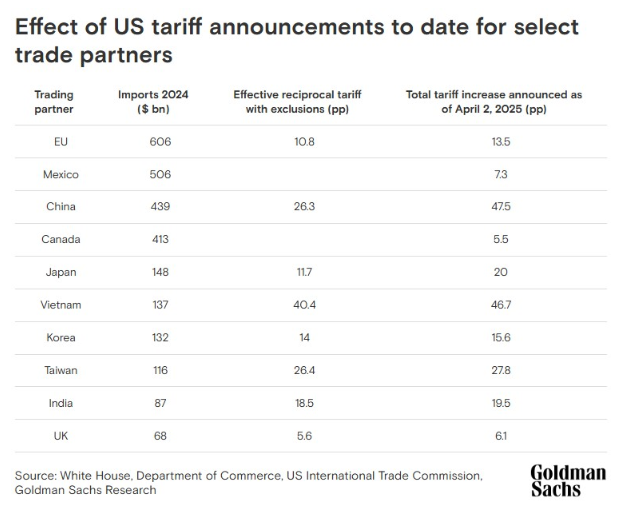
Bulls usually win over bears in the long-term. Can long-term value win over growth?
OK, so by now we are all feeling the pain that the tariffs have turned into a trade war and the risks of recession have moved from a possibility into a real risk. A serious question that consumers, investors, purchasing managers and business owners all need to be asking is how the tariffs are truly going to impact them in real dollars and sense.
According to Goldman Sachs Research, the weighted average tariff rate of 18.3% on U.S. trade partners was about 3 percentage points higher than it had expected. One big issue to consider is that roughly one-third of total imports coming into the U.S. would be exempt. This effectively reduces the impact to a 12.6 percentage point increase in the effective tariff rate.
The long and short is that a 1% tariff hike is not a 1% hike to inflation. That doesn’t mean it comes at no cost.
Goldman Sachs is now forecasting that the US effective tariff rate will rise 18.8 percentage points. And while this is before the retaliation from China, its economists Alec Phillips and Elsie Peng assume trading partner negotiations will lead to somewhat lower reciprocal rates than announced this week. Still, the team warned:
However, the prospect for escalation following retaliatory tariffs and a high probability of further sectoral tariffs suggest the US effective tariff rate could rise more than the 15 percentage points our economists had previously expected.
Now, what about the impact for a recession? Economic growth is most easily measured in terms of gross domestic product (GDP). Goldman Sachs noted that tariffs impact economic growth “through their tax-like impact on real disposable income and consumer spending…”
There is more to how this can impact GDP though. Tariffs have a tendency to unnerve markets and tighten financial conditions. There is also the impact of uncertainty about trade policy on business investment. And there is also a modest offsetting effect of a narrower trade deficit to consider. And what about the help from tax reform? The Goldman Sachs report warns:
While the personal and corporate tax changes that Congress is likely to pass will modestly boost growth, fiscal policy is unlikely to offset the hit from tariffs and immigration this year.
But how do the full implications of tariffs really come down on consumers. The long and short of the matter is that a 1% hike in tariffs is not a 1% price hike in total prices. Goldman Sachs estimates that its team’s rule of thumb for inflation is that every 1 percentage point hike in the effective tariff rate will raises core PCE prices by about 0.1 percentage point.
Goldman Sachs recently lowered its 2025 forecast on the S&P 500 for the second time. It has a suggestion for investors to “be nimble” — effectively putting a tactical investor mindset in place. Their call:
“Use pops in the broader market as a chance to reduce exposure. And then on dips, look to scale into companies that you can believe in the fundamental story and hold long-term.”
Below is the Goldman Sachs table showing the total tariff table and then the effective reciprocal tariff rates after factoring in the exclusions.
